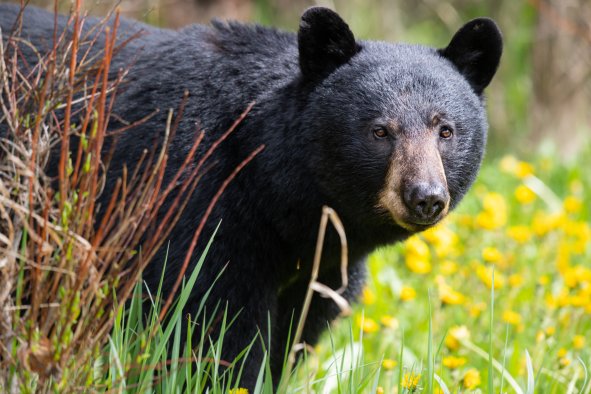An endangered species of shark has been observed having "virgin births" for the first time.
Two of these common smooth-hound sharks (Mustelus mustelus) were seen giving birth to their young without the involvement of males at the Cala Gonone Aquarium in Sardinia, Italy, according to a new paper in the journal Scientific Reports. This is the first time that reproduction without having had sex—known as parthenogenesis—has been seen in this species.
"This study reports the first case of facultative parthenogenesis in the common smooth-hound shark Mustelus mustelus, a species classified by IUCN as endangered," the researchers wrote, referring to the International Union for Conservation of Nature.
The two captive sharks, both 18, have been seen giving birth via parthenogenesis nearly every year since 2020, according to the paper. All of the offspring were female.
Parthenogenesis is a biological phenomenon where females of a species give birth to—or lay eggs containing—offspring without having had an egg fertilized by the sperm of a male. Offspring produced through parthenogenesis are typically clones of the mother and lack genetic diversity, but some variations can occur because of mutations.
"Many different types of parthenogenesis have been described in each vertebrate taxon, except mammals," the authors wrote.
Obligate true parthenogenesis, which is when a species is exclusively reproduced by parthenogenesis, is rare. It is seen in only around 100 vertebrate species and about 1,000 invertebrates.
Facultative parthenogenesis, which is what is being seen in these common smooth-hound sharks, allows an animal to reproduce both sexually and asexually, depending on the circumstances. Females can produce offspring without fertilization by a male but can still reproduce sexually when males are available. This is seen in several species and can be triggered by males becoming scarce or absent, as well as stressful or changing environments.
The two sharks were seen birthing young in 2020, 2021 and 2023, with no males present for 13 years. The researchers weren't initially sure if this was parthenogenesis, as these sharks can store sperm for a very long time. This species is known to store sperm in its reproductive tract for up to three months, but other species of sharks and rays have been seen storing sperm for as long as 45 months.
The scientists used genetic testing to figure out if the young had been made using parthenogenesis or via sperm storage. They discovered that they were parthenogenetically developed, as the young had no non-maternal genes.
"Remarkably, this finding reveals that parthenogenesis can occur annually in these sharks, alternating between two females, and conclusively excludes long-term sperm storage as a cause," the researchers wrote. "Consequently, this enhances our understanding of parthenogenesis in elasmobranchs and highlights the reproductive flexibility of M. mustelus."
This phenomenon has been seen in captive sharks and rays several times, including in zebra sharks in Chicago's Shedd Aquarium, in swell sharks in the National Aquarium at the Animal Care and Rescue Center in Baltimore and in white-spotted eagle rays at the Living Seas aquarium in Orlando, Florida.
The common smooth-hound shark is an endangered species and is found in the Mediterranean, eastern Atlantic and the western Indian Ocean. This species has had huge population declines in recent decades, dropping by over 50 percent over the past 50 years. This is mostly because of illegal fishing, especially of younger specimens as well as bycatch.
In the wild, parthenogenesis is usually seen only when a population is in decline, such as in the small-tooth sawfish. Therefore, by understanding parthenogenesis we can better understand the population dynamics of endangered species and help them recover.
"Understanding reproductive parameters like fecundity, sexual maturity, and longevity remains critical for species management and conservation. Aquarium settings play a pivotal role in advancing our knowledge of parthenogenesis regulation in elasmobranchs, otherwise challenging in the wild," the researchers wrote.
They continued: "While advantageous, parthenogenesis in endangered species may lead to reduced genetic diversity, exacerbating challenges faced by sharks amidst fishing pressures and long gestation periods. Maintaining shark populations is crucial for ecological balance and marine ecosystem stability."
Sadly, only one of the sharks from these "virgin births" is still alive. The others were found dead, with deformities and bite marks present all over their bodies. The shark in the 2021 birth was also found with bite marks but survived and lives to this day.
"All parthenogenetically born M. mustelus exhibited visible bite marks, likely inflicted by adult females during or immediately after birth, influenced by environmental or other factors," the researchers wrote. "Understanding these behaviors across shark species warrants further investigation."
Do you have a tip on a science story that Newsweek should be covering? Do you have a question about parthenogenesis? Let us know via science@newsweek.com.
Disclaimer: The copyright of this article belongs to the original author. Reposting this article is solely for the purpose of information dissemination and does not constitute any investment advice. If there is any infringement, please contact us immediately. We will make corrections or deletions as necessary. Thank you.



